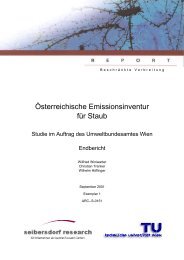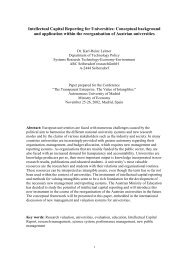ALPMON FINAL REPORT - ARC systems research
ALPMON FINAL REPORT - ARC systems research
ALPMON FINAL REPORT - ARC systems research
Create successful ePaper yourself
Turn your PDF publications into a flip-book with our unique Google optimized e-Paper software.
Contract ENV4-CT96-0359 <strong>ALPMON</strong><br />
different approaches towards generalisation. Visual interpretation usually defines the dominant class in<br />
an image as “background” and “cuts out” the remaining classes. The post-processing technique is<br />
always limited to the local neighbourhood and therefore does not consider dominant classes in a larger<br />
environment.<br />
A major reason for the confusion between the data sets can be found in the differences between the<br />
nomenclatures, despite the effort of harmonisation, or in the interpretation of the nomenclature. This is<br />
stated in the confusion between forest and shrubland or between meadows / pastures, sparse<br />
vegetation and rocks. Here the problem is a clear definition of class limits, both in terms of space and<br />
theme. Delineation of land cover types is critical, if the spatial transition is continuos, e.g. between<br />
forest and shrubland. Differentiation of land cover types is critical, if the thematic transition is continuos,<br />
e.g. between sparse vegetation and rocks. A significant difference can also be found in the<br />
interpretation of forest types. Mixed forest in <strong>ALPMON</strong> is to a high extent interpreted as coniferous<br />
forest in CORINE, while parts of coniferous forest in <strong>ALPMON</strong> are confused with natural grassland and<br />
heathland in CORINE. The latter is due to the fact that dwarf mountain pine was defined as heathland<br />
in the CORINE nomenclature. The over estimation of coniferous forest at costs of mixed forest in<br />
CORINE – as confirmed by aerial images – might be due to the differences in the original minimal<br />
mapping unit, i.e. the different approaches to generalisation.<br />
In general it has to be noted that the confusions in the different test sites do not show the same<br />
pattern. As a unique and reproducible processing chain was used in <strong>ALPMON</strong> to ensure comparable<br />
results for the test sites, it is likely that the CORINE data sets are not totally compatible. This becomes<br />
evident when comparing the single CORINE land cover maps from the different countries involved –<br />
Germany, Austria and Italy. For Switzerland the situation is different, as the standardised CORINE land<br />
cover map is not available. Final conclusions lead to the impression that the different approaches<br />
cannot be directly combined, at least not on level 3 of the CORINE nomenclature. Comparing the land<br />
cover maps on level 2 could lead to spatial indicators that might help the interpreter to concentrate on<br />
areas that are likely to have changed, or have been incorrectly assigned in the first version of the<br />
CORINE land cover map. The final decision on the land cover type, however, should be left to the<br />
interpreter. Such a combined approach would help to overcome the inconsistencies that appear in<br />
visual interpretation, such as overlooking single land cover units, but at the same time would benefit<br />
from the human vision system for detailed interpretation.<br />
The introduction of level 4 classes to the CORINE nomenclature is considered possible for forest<br />
areas. While CORINE only differentiates three forest classes – coniferous, mixed and broad-leaved<br />
forest – the <strong>ALPMON</strong> classification takes into account forest types, age classes and crown coverage.<br />
However, it is to be noted that with an increasing level of detail the reliability of these classes is<br />
significantly decreasing. No conclusions can be given for other level 4 classes, such as for artificial<br />
surfaces or agricultural areas, as these land cover types hardly occur in alpine areas and thus were not<br />
of major interest for the <strong>ALPMON</strong> project.<br />
JR, RSDE, ALU, LMU, Seibersdorf, WSL 63




